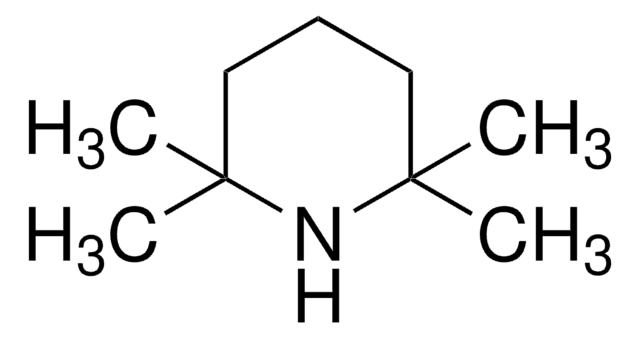69581
Pyrrolidin
analytical standard
Synonym(e):
Tetrahydropyrrol, Tetramethylenimin
About This Item
Empfohlene Produkte
Qualität
analytical standard
Qualitätsniveau
Dampfdichte
2.45 (vs air)
Dampfdruck
128 mmHg ( 39 °C)
49 mmHg ( 20 °C)
Assay
≥99.0% (GC)
Selbstzündungstemp.
653 °F
Haltbarkeit
limited shelf life, expiry date on the label
Expl.-Gr.
10.6 %
Methode(n)
HPLC: suitable
gas chromatography (GC): suitable
Verunreinigungen
≤0.5% water
Brechungsindex
n20/D 1.442-1.444
n20/D 1.443 (lit.)
Dichte
0.852 g/mL at 25 °C (lit.)
Anwendung(en)
cleaning products
cosmetics
flavors and fragrances
food and beverages
personal care
Format
neat
SMILES String
C1CCNC1
InChI
1S/C4H9N/c1-2-4-5-3-1/h5H,1-4H2
InChIKey
RWRDLPDLKQPQOW-UHFFFAOYSA-N
Suchen Sie nach ähnlichen Produkten? Aufrufen Leitfaden zum Produktvergleich
Anwendung
Empfohlene Produkte
Signalwort
Danger
H-Sätze
Gefahreneinstufungen
Acute Tox. 4 Inhalation - Acute Tox. 4 Oral - Eye Dam. 1 - Flam. Liq. 2 - Skin Corr. 1A
Lagerklassenschlüssel
3 - Flammable liquids
WGK
WGK 1
Flammpunkt (°F)
37.4 °F - closed cup
Flammpunkt (°C)
3 °C - closed cup
Hier finden Sie alle aktuellen Versionen:
Analysenzertifikate (COA)
Die passende Version wird nicht angezeigt?
Wenn Sie eine bestimmte Version benötigen, können Sie anhand der Lot- oder Chargennummer nach einem spezifischen Zertifikat suchen.
Besitzen Sie dieses Produkt bereits?
In der Dokumentenbibliothek finden Sie die Dokumentation zu den Produkten, die Sie kürzlich erworben haben.
Kunden haben sich ebenfalls angesehen
Unser Team von Wissenschaftlern verfügt über Erfahrung in allen Forschungsbereichen einschließlich Life Science, Materialwissenschaften, chemischer Synthese, Chromatographie, Analytik und vielen mehr..
Setzen Sie sich mit dem technischen Dienst in Verbindung.









